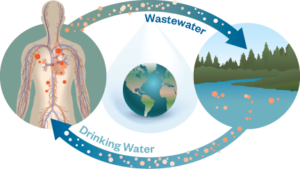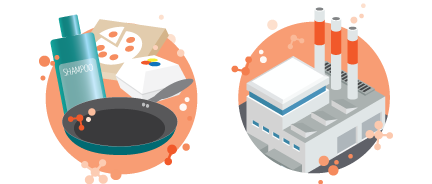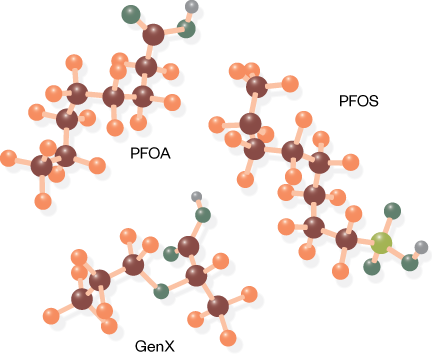PFAS Information & Resources
What are PFAS?
Perfluoroalkyl and polyfluoroalkyl substances (PFAS) are a large group of man-made chemicals used since the 1940s in common household and commercial products. PFAS have unique chemical properties and are resistant to heat, water, and oil. They have been used to make cookware, carpets, clothing, fabrics for furniture, paper packaging for food, and other materials that are resistant to water, grease, or stains. The chemicals are used in firefighting foams and in a number of industrial processes.
Many recent news articles and movies focus on PFAS, typically when they are found in local drinking water. Water gets this media attention because it is regularly tested for potentially harmful chemicals by law, unlike many of the other things we eat, drink, and breathe.
PFAS are slow to break down in the environment and can move far from their original use areas. The manufacturing and use of these products put PFAS into the environment, where, over time, they may end up in drinking water supplies. Understanding how PFAS can enter our environment, our homes, and our bodies can help us manage our exposure.
How Does PFAS Enter the Environment?
- PFAS can enter the environment as we throw away products that have PFAS, and through our own bodily waste.
- PFAS can also enter the environment when companies make products with PFAS, releasing it directly into our water and air.
- Natural breakdown of PFAS is negligible or sometimes non-existent, allowing PFAS to build up and remain in the environment. This leads to increasing levels of PFAS in the natural resources we use from the environment, like water, food, and soil.
How are Humans Exposed?
Because PFAS are used in so many everyday products, most people in the United States and other industrialized countries now have PFAS in their blood. Exposure to PFAS depends on many things, including the amount of PFAS in your local environment, the amount of PFAS in food, water, or other products, and how much a person eats, drinks, or uses those products.
- We swallow, inhale, or rub PFAS into our skin by using certain products, eating or drinking impacted food and water, and breathing in the dust in our homes.
- As in the environment, PFAS can build up in the human body over time and have been associated with some negative health effects.
Learn about PFAS regulatory changes on our Water Quality Updates page.
What is LCA Doing to Manage PFAS?
LCA has been monitoring for various PFAS substances over the past few years and some water sources have shown low levels of PFAS.
On July 24, 2023, the LCA Board of Directors approved funding for a study of the four water sources that supply the Allentown Division water filtration plant (Schantz Spring, Crystal Spring, Little Lehigh Creek, and the Lehigh River). The purpose of the study is to determine if additional treatment will be needed to best protect public health and remain in compliance.
LCA will provide updates on our website as new information on PFAS becomes available.
LCA PFAS Sampling Results
View LCA’s sampling results for PFAS.
How Does PFAS Affect Me?
Scientists are still studying the health effects of elevated PFAS blood levels, which may include increased risk of certain types of cancer, high cholesterol, and decreased vaccine response in children. Blood tests can tell us how much PFAS we may have in our blood compared to population averages. But blood testing is not prognostic (suggestive of a future health effect) or diagnostic (linked to a current health effect). As scientists complete more studies, more information will be available on the health effects of high PFAS blood levels and regulations related to PFAS will continue to change.
The National Health and Nutrition Examination Survey (NHANES) found that PFOA and PFOS blood levels have dropped more than 60% and 80% respectively between 1999 and 2014, since manufacturers stopped using them in 2000. PFOA and PFOS are two common PFAS that are the focus of recent state and federal regulatory deliberations. Thousands of different PFAS chemical compounds are still in use. The effects of newer PFAS are still not known, but the studies suggest that phasing out harmful chemicals can make a big difference.
Look to official sources of information to stay current on the latest research developments. Reliable sources include:
• The Centers for Disease Control
• The U.S. Environmental Protection Agency
PFAS can enter the environment as we throw away products that have PFAS, and through our own bodily waste. The natural breakdown of PFAS is negligible or sometimes non-existent, allowing PFAS to build up and remain in the environment. This leads to increasing levels of PFAS in the natural resources we use from the environment, like water, food, and soil.


We can swallow, inhale, or rub PFAS into our skin by using products that have PFAS, eating or drinking food/beverages that have PFAS, and breathing in the dust in our homes. PFAS can also enter the environment when companies make products with PFAS, releasing it directly into our water and air.
PFOS and PFOA are two of the most well-known and studied PFAS. Though production stopped in 2000, they are still found in our environment. Newer PFAS, like “GenX,” are now used in their place.

How Does PFAS Affect Your Water?
Protecting public health is our first priority. That’s why we look for potentially concerning contaminants like PFAS long before they are regulated. Water quality is regulated to protect public health and drinking water quality is public information. Because of this, water often provides our first clues about trends we need to pay attention to.
Water also connects all of us. Vast as it may seem, our world is a closed system. There is no such thing as “new” water. All water is shared, and it flows in and out of streams, rivers, oceans, and each of us. Along the way, it often carries the things we put in it, including chemicals like PFAS. Water utilities are responsible for maintaining water quality according to regulations while also keeping drinking water affordable. Treatment to remove PFAS from water can happen at utilities and in our homes – using technologies like activated carbon and reverse osmosis – but treatment can be expensive. Our country’s regulatory process helps make sure we are delivering the safest water at a cost affordable to all. Together with many partners, we take steps to protect our source waters from emerging contaminants, and we test and treat your drinking water to the standards set by U.S. EPA and [state primacy agency}. We openly share water quality information on our website at About Your Water | Lehigh County Authority. This website is the best place to find reliable information about relevant regulations and your local drinking water quality.
How Can We Reduce Exposure to PFAS?
PFAS exposure can vary depending on your local environment, but you can take steps to reduce the PFAS around you. Choosing products that do not have PFAS can require some research, but it is an effective way to reduce your exposure. It can also mean giving up some product features such as “non-stick,” or “water- or stain-resistant.” Consider replacing older and worn-out products with these features.
What Can I Do?

- Avoid buying non-stick cookware and stain-resistant furniture and carpeting containing PFAS. Look for ‘fluoro’ or ‘perfluoro’ in a list of ingredients or ask the manufacturer. You may also find this summary of PFAS product information and certification resources useful. (link to document PFAS Product Information and Certification Resources).
- Limit eating foods packed in materials that use PFAS. Common food packaging that may have PFAS includes microwave popcorn bags, fast food boxes (like french-fry containers and pizza boxes), and bakery bags.
- Minimize the dust in your home to limit PFAS particles in the air. Change your home’s air filter on a regular basis and leave your shoes at the door to avoid tracking in dirt and pollutants.
- Avoid personal care products that contain PFAS. These include certain types of dental floss, nail polish, facial moisturizers, and cosmetics.
- Learn about the PFAS levels in your local drinking water. If you want an at-home treatment option, look at the NSF International list of products certified to remove PFAS from drinking water in the home.
- PFASCentral.org maintains a list of manufacturers and retailers that have taken steps to remove PFAS chemicals from their products.
Water Filters and Home Treatment Devices
The DrinkTap website provides resources to help you learn about water filters and home treatment devices for your specific circumstances.
LCA will inform customers as we learn the impact of new PFAS regulations on local drinking water. We are committed to our mission to protect public health and the environment by providing high-quality, safe, and reliable water and wastewater services!